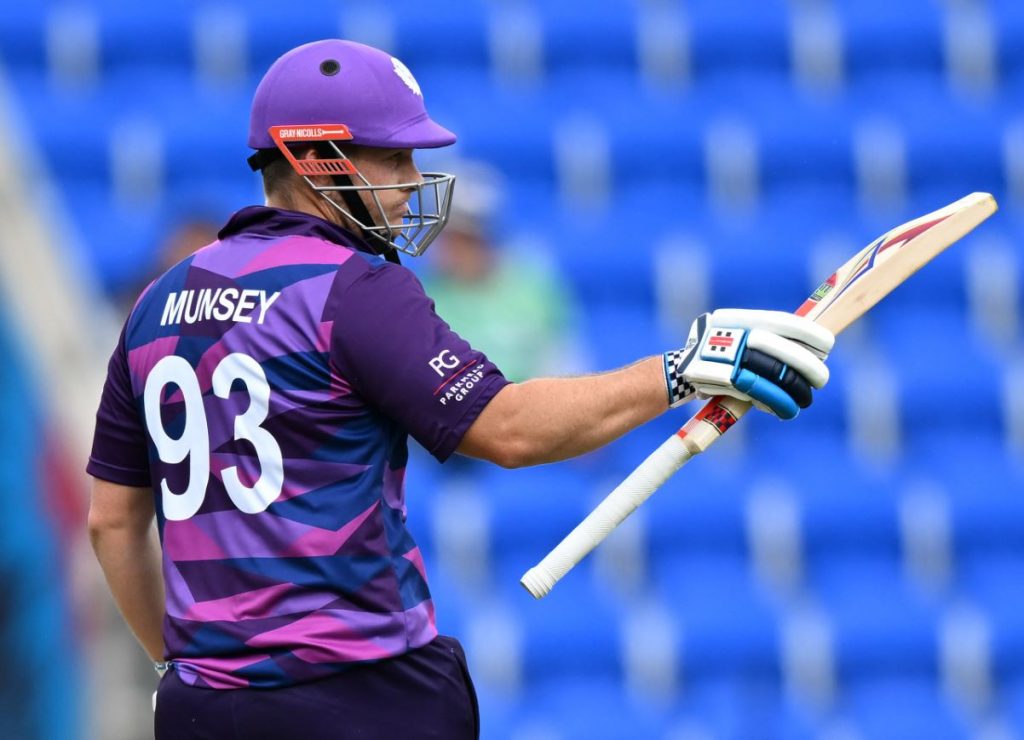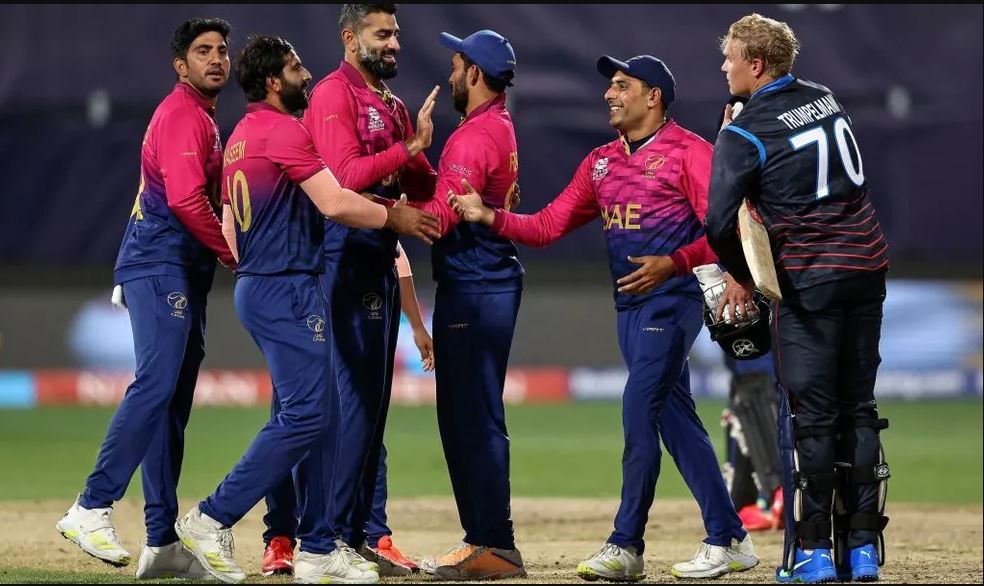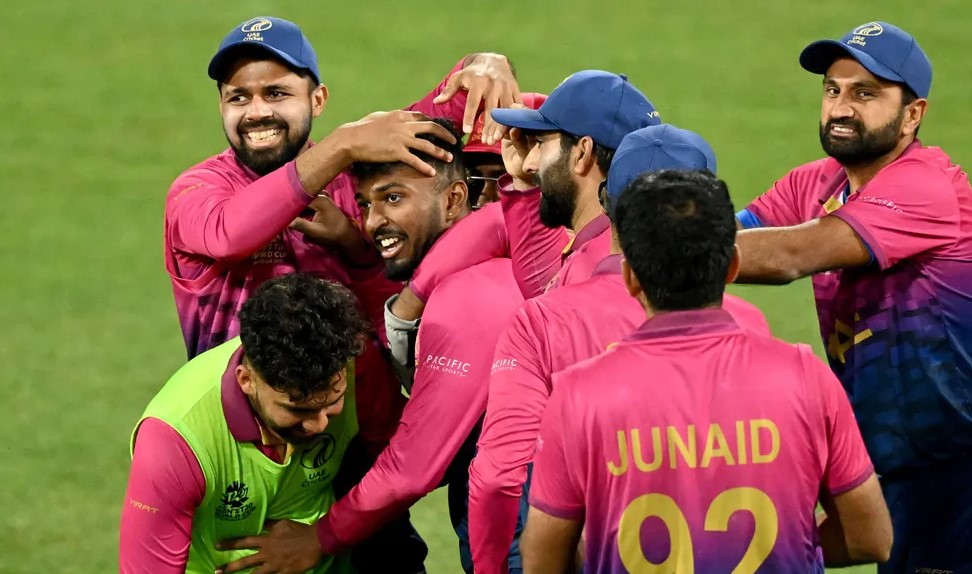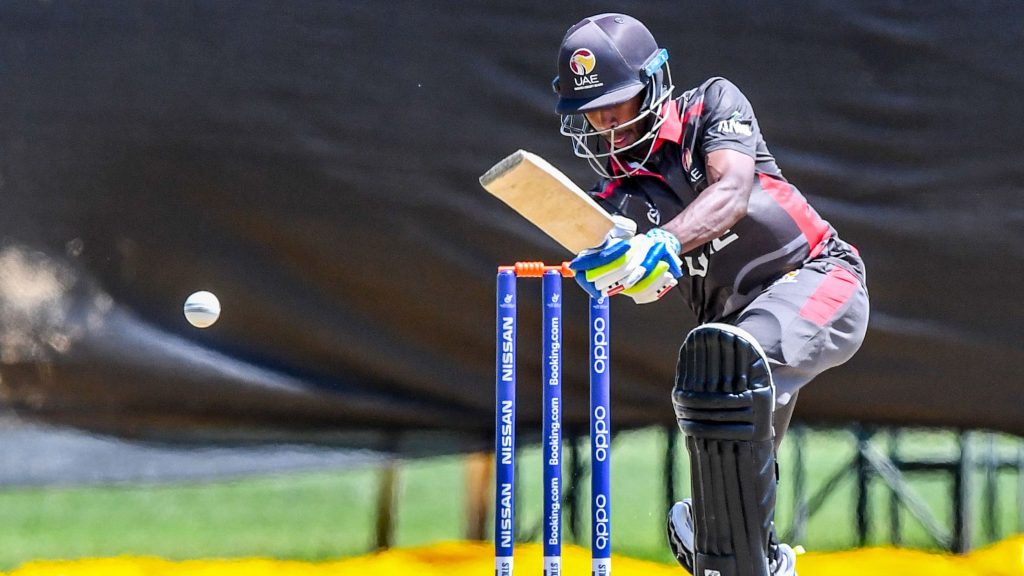Scotland
Rating – 6.5

Qualification was always going to be a struggle for the Scots, placed as they were in the proverbial group of death alongside Ireland, West Indies and Zimbabwe. However, they made decent fist of it and came agonisingly close to the Super 12 stage. Like Namibia, the Scots kickstarted their campaign with a win, shocking the cricket world by thrashing two time World Cup winners West Indies by 42 runs. In the next game, they scored 176/5 and had opponents Ireland teetering at 61/4 in 9.3 overs, only for a whirlwind, outrageous partnership between Curtis Campher and George Dockrell to take the game away.
Still, the Scots had qualification in their hands going into the do or die final group game game against the Zimbabweans. But alas it was not to be! Disciplined bowling by the Chevrons restricted Scotland to a low total of 132, before Craig Ervine and Sikandar Raza starred in a quickfire 64 runs partnership to chase down the required target.
Batting:
Batting wise, George Munsey was the clear standout. The burly left hander scored two half centuries against West Indies and Zimbabwe, although they came at a slower than normal strike rate of 114.15. Fellow opener Michael Jones was the other batter to surpass 100 runs at the tournament. He played a blistering innings of 86 in 55 balls against the Irish in a losing cause.

Bowling:
Brad Wheal was a steady presence with the ball, picking up 4 wickets at an average of 20.75. However, both his fast bowling partners Safiyaan Sharif and Josh Davey failed to make an impact and had largely forgettable outings.
In the spin department, Mark Watt continued to enhance his reputation on the world stage. He was the undisputed leader of Scotland’s bowling attack with an excellent return of 5 wickets at an average of 14 and a parsimonious economy rate of 5.83. Allrounder Michael Leask had a quiet tournament with the bat, but complemented Watt excellently with the ball in hand, picking up 4 wickets. Inexplicably, Hamza Tahir was not selected for the final playing XI in any of the games, despite his recent track record of bowling well in tandem with Watt in multiple ODI series, prior to the tournament. Chis Greaves, hero of last year’s World Cup win against Bangladesh, was also underutilised and only bowled two overs in the entire tournament.
Highlights:
The lead up to the T20 World Cup had Scottish cricket mired in controversy with damning allegations of discrimination from former players and a report that identified 450 specific examples of institutional racism. However, the Scots made their cricket do the talking on the field with a stunning win over West Indies to open proceedings in Group B. Coming on the back of Namibia’s upset of Sri Lanka, both these victories injected life and excitement into the first round and captured the attention of the wider cricketing world.
Lowlights:
Scotland let Super 12 qualification slip from their grasp after failing to take followup wickets against Ireland and Zimbabwe; having reduced the aforementioned teams to 61/4 and 42/3 respectively. Aside from Mark Watt, the lack of another X factor bowler or a genuine wicket taking pace option was evident as they failed to press home the advantage at key moments. Perhaps the emergence of an additional strike bowler or two would really make a difference to Scottish fortunes in the future.
United Arab Emirates
Rating – 5

Making their 2nd ever appearance at a T20 World Cup (first one was in 2014), United Arab Emirates (UAE) had a mixed bag of results. They almost pulled a rabbit out of the hat in their inaugural game against Netherlands, making a spirited but ultimately unsuccessful defence of 111 runs. Fast bowler Junaid Siddique had a day out with 3/24 and threatened to win the game for UAE; but old fashioned ODI batting and hard running by Tim Pringle and Scott Edwards saved the Dutch blushes.
In their second game, an inspired bowling performance by leg-spinner Karthik Meiyappan (including a hat-trick) restricted Sri Lanka to a total of 152/8, after they looked set to post a daunting score of 180+ on a good batting surface. Unfortunately in response, the batters were blown away by the Lankan bowling to be all out for 73.

The successive defeats sealed UAE’s exit from the World Cup, but with nothing but pride on the line, the Emiratis put in a performance for the ages. The batting finally clicked as an unit, propelling them to a decent score of 148/3. Despite David Wiese’s valiant efforts, the Eagles fell short by seven runs after disciplined bowling by Basil Hameed and Zahoor Khan had restricted the scoring early on. It was a momentous occasion for the Gulf Nation to register their first ever win at a ICC T20 World Cup and also ensured that they wouldn’t leave the tournament empty handed.
Batting:
UAE’s batters really underwhelmed in the first round with only Muhammad Waseem scoring a half-century and showing any semblance of fluency. No other batter even passed fifty runs for the tournament. Captain Rizwan made a quickfire 43 not out in the last game, but that was preceded with scores of 1 and 1 versus Netherlands and Sri Lanka. Disappointingly, Vriitya Aravind also failed to live up to his pre-tournament billing and had a horrid time with the bat on the sluggish Geelong surfaces.
Bowling:
The bowling on the other hand was a real positive for UAE. They bowled with disciplined lines and lengths and made life hard for each of their three opponents. Zahoor Khan impressed with his accurate lengths and late swinging yorkers, picking up 5 wickets at 11.40 and only conceding 4.75 runs an over. Zahoor’s pace bowling partner Junaid Siddique took 4 wickets but had a patchy tournament, going for plenty of runs in the last two games.
In the spin department, Karthik Meiyappan was simply sublime. The 22 year old leg spinner ended up as the joint highest wicket-taker for UAE alongside Zahoor with five wickets at an average of 15. Basil Hameed bowled a mere five overs but nabbed three scalps. Ayaan Afzal Khan, the 16-year-old schoolboy prodigy, looked right at home on the international stage and will only get better with time and experience. Here, he delivered eight miserly overs with an economy rate of 4.75, whilst dismissing two batters in the process.
Highlights:
One of many young bright talents in the UAE team, Karthik Meiyappan took the World Cup by storm with his sensational hat-trick against Sri Lanka. Bowling a trio of googlies, he first had Bhanuka Rajapaksa caught at deep cover trying to up the ante, followed by a widish flighted delivery which kissed the outside edge of Charith Asalanka’s bat. The hat-trick ball was the best of the lot, drifting in on off-stump before sneaking in between Dasun Shanaka’s forward defence and his pads to rattle the stumps.
Another highlight was provided by Muhammad Waseem’s slow medium trundlers which memorably helped his team achieve their first ever victory at a T20 World Cup. An opening batter who had delivered a sum total of 22 balls in his international T20 cricket career thus far, Waseem was tasked with stopping the Namibian march to victory. He rose to the occasion in fine fashion. His first over cost 10 runs, including a dropped catch of danger man David Wiese. But with 14 runs to defend in the last over, Waseem bowled a succession of wobbling full balls to restrict boundaries and dismissed Wiese off the fourth ball, which ultimately delivered the killer blow.
Lowlights:

Vriitya Aravind was expected to play a big part for UAE at the T20 World Cup after outstanding performances in Global Qualifier A. Unfortunately, the 20-year-old wicketkeeper-batter and vice-captain never came to the party. While Aravind was an enthusiastic presence behind the stumps, he had a terrible tournament with the bat, scoring only 48 runs in three games with a high score of 21. Of bigger concern was his lowly strike rate of 67.60 which highlights just how much he struggled to rotate the strike and find any fluency. However, time is on the young man’s side and he possesses oodles of talent to turn things around in the near future.
You’re reading Emerging Cricket — brought to you by a passionate group of volunteers with a vision for cricket to be a truly global sport, and a mission to inspire passion to grow the game.
Be sure to check out our homepage for all the latest news, please subscribe for regular updates, and follow EC on Twitter, Facebook, LinkedIn and YouTube.
Don’t know where to start? Check out our features list, country profiles, and subscribe to our podcast.
Support us from US$2 a month — and get exclusive benefits, by becoming an EC Patron.






